|
|
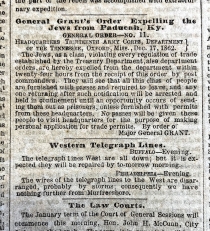
|
Grant’s Infamous General Order 11 Expelling Jews—and Lincoln’s Revocation of it
Abraham Lincoln,
Collection of eleven original historic newspapers.
“The Jews, as a class, violating every regulation of trade established by the Treasury Department, also department orders, are hereby expelled from the department within twenty-four hours from the receipt of this order by post commanders.”
—Grant’s General Orders No. 11, in the New York Herald, Jan. 5, 1863
This Collection of eleven original historic newspapers starts as soon as Grant’s infamous order reached New York on January 4th, 1863. (It was common for news sent to Washington D.C. to reach New York, the main telegraph communications hub, first.) That same day, a delegation of Jews that had arrived from Paducah Kentucky to protest the order went to Ohio Congressman John Gurley, who took them to the White House. Lincoln, while dealing with prosecuting the war and watching for reaction to the Emancipation Proclamation—which he had just issued on January first—received them right away.
Lincoln immediately directed General-in-Chief Henry W. Halleck to have Grant revoke the order. Early on January 5th, Halleck telegraphed Grant that “a paper purporting to be General Orders, No. 11, issued by you December 17, has been presented here. By its terms, it expells all Jews from your department. If such an order has been issued, it will be immediately revoked.” Grant rescinded his order on January 6, 1863.
Publication of the order, its revocation, and resolutions in the Senate and House (both legitimately objecting, and also using the order as an excuse to attack Grant and Lincoln), are included in the collection.
Item #25501, $11,000
|

|
The Only Abraham Lincoln Letter to his Fiancée Mary Owens Still in Private Hands—Long on Politics, Short on Love
ABRAHAM LINCOLN,
Autograph Letter Signed, to Mary S. Owens, December 13, 1836, 2 pp., 9¾ x 7¾ in.
“Write back as soon as you get this, and if possible say something that will please me, for really I have not been pleased since I left you.”
Here, Lincoln perfectly demonstrates what Owens later described as deficiencies “in those little links which make up the chain of a woman’s happiness.” Rather than expressing his feelings for Owens, Lincoln complains about his health and discusses political issues swirling in the Illinois General Assembly. Although inept at love, the letter offers rare insight into the young representative’s thoughts on a variety of political issues. In this highly important letter to Mary Owens, a self-absorbed Lincoln complains to his potential spouse of his health, both physical and mental, and discusses political issues to the point that he describes his own letter as “dry and stupid.” Perhaps more revealing than he realized, it illustrates the tension in Lincoln’s early life between matters of the head, with which he was comfortable, and matters of the heart, with which he clearly was not.
Item #24346.99, $375,000
|
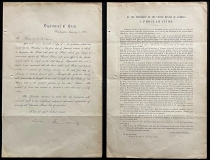
|
Very Early State Department Printing of Lincoln’s Emancipation Proclamation and William Seward’s Cover Letter, Sent to American Minister in Argentina
ABRAHAM LINCOLN,
Printed Circular, “By the President of the United States of America. A Proclamation.” First page: WILLIAM H. SEWARD, Printed Letter Signed by Secretary, to Robert C. Kirk, January 3, 1863. [Washington: Government Printing Office, ca. January 5, 1863], 2 pp. on one folded sheet, 8¼ x 13 in. (pages 2 and 4 blank)
“By virtue of the power, and for the purpose aforesaid, I do order and declare that all persons held as slaves within said designated States, and parts of States, are, and henceforward shall be free; and that the Executive government of the United States, including the military and naval authorities thereof, will recognize and maintain the freedom of said persons…”
One of the first obtainable printed editions of Abraham Lincoln’s final Emancipation Proclamation, January 1863, issued by the State Department.
Item #27119.99, $115,000
|

|
Abraham Lincoln Introduces Ulysses S. Grant’s Superintendent of Freed Slaves to the American Freedmen’s Inquiry Commission
Abraham Lincoln,
Autograph Letter Signed as President, to Robert Dale Owen, July 22, 1863, Washington, D.C. On Executive Mansion stationery. 1 p., 5 x 8 in.
“Mr John Eaton Jr. … having had charge of the freed-men … comes to me highly recommended by Gen. Grant, as you know, & also by Judge Swayne[1]of the U. S. Supreme Court.
On July 22, 1862, exactly a year before he wrote this letter, Lincoln read a draft of the Emancipation Proclamation to his cabinet, agreeing to Stanton’s advice to hold it back until the Union could claim a military victory. On September 22, after the Battle of Antietam, he issued a Preliminary Proclamation, stating that enslaved people in any areas still in rebellion would be freed, and that freed men would be welcomed into the armed forces of the United States. Once Lincoln issued the final Emancipation Proclamation on January 1, 1863, Secretary of War Edward Stanton worked to create a federal system to support freed slaves, and allow them to most effectively support the Union.
Item #26470, $75,000
|

|
After Investing in its Stock, Lincoln Represents a Railroad in a Precedent-Setting Lawsuit
ABRAHAM LINCOLN,
Autograph Manuscript Signed by Lincoln in text, constituting his official transcript of the “Subscription Book of the Capital Stock of the Alton and Sangamon Rail Road Company,” incorporated February 27, 1847, transcribed in early 1851. Comprising a cover sheet titled in Lincoln’s hand, the joint stock subscription statement and list of 91 shareholders with the number of shares subscribed, and leaf with Lincoln’s legal docket: “Alton and Sangamon Railroad Company vs. James A. Barret. Copy of contents of subscription book....” 8 pp., 6⅝ x 8¼ x ¼ in.
A list of stockholders, entirely in Lincoln’s hand, filed as evidence in his first significant railroad case. Lincoln’s own appearance in the shareholder list represents only the second known instance of a stock purchase by the future president. The Illinois Supreme Court’s ultimate ruling in favor of Lincoln and the railroad set an important legal precedent, upholding the binding nature of a stockholder’s contractual and financial obligations. “The decision, subsequently cited in twenty-five other cases throughout the United States, helped establish the principle that corporation charters could be altered in the public interest, and it established Lincoln as one of the most prominent and successful Illinois practitioners of railroad law” (Donald, p.155).
Item #27561, $198,000
|

|
Abraham Lincoln Signed Military Commission for Secretary of Navy Gideon Welles’s Son
ABRAHAM LINCOLN,
Partially Printed Document Signed, as President, commission appointing Thomas Glastonbury Welles Aide-de-Camp with the rank of captain, March 13, 1865, Washington, D.C. Countersigned by Secretary of War Edwin M. Stanton. On vellum, 15¾ x 19½ in.
A rare commission for the sone of one of Lincoln’s most important cabinet members, signed nine days after his second inauguration and just over a month before his assassination.
President Lincoln signed this military commission to promote Thomas G. Welles, the eighteen-year-old son of his Secretary of the Navy, to an aide-de-camp with the rank of captain. A month later, he was present at the surrender of General Robert E. Lee’s Army of Northern Virginia at Appomattox Court House in Virginia. A few months after that event, Welles was promoted to the brevet rank of major and left the army with the brevet rank of lieutenant colonel in 1866.
Item #27437, $15,000
|
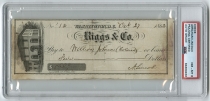
|
Abraham Lincoln Signed Check to “William Johnson (Colored)”—Who Accompanied the President to Antietam and Gettysburg
ABRAHAM LINCOLN,
Partially Printed Document Signed, Riggs & Co. Bank check, October 27, 1862, Washington, D.C. 1 p., 7½ x 2¾ in. Filled out and signed by Lincoln as president, payable to “William Johnson (Colored)” for $5.
Johnson accompanied Lincoln from Springfield to Washington, D.C., served as the President’s valet, and traveled with him to Antietam (25 days before this check) and a year later to Gettysburg.
Item #27740, $175,000
|
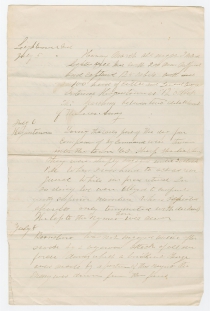
|
A Fighting Vermont Regiment Summary of Actions after Gettysburg, July 5-13, 1863
ADDISON W. PRESTON,
Autograph Document, c. July to October 1863, 2 pp., 8 x 12¼ in.
Item #23879.01, $1,250
|

|
Alex Haley Signed Check
ALEX HALEY,
Signed Check, September 20, 1988. Drawn on the First Tennessee Bank in Knoxville. To “Patricia Alexander”. With “Love!” in the memo field and on the back is her endorsement and a note that says “Thanks!”.
Item #20432.02, $350
|
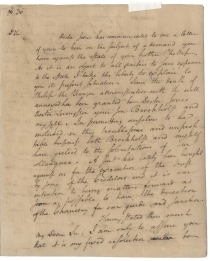
|
Hamilton LS on Declaration-Signer Philip Livingston's Estate, Ten Years After His Death
ALEXANDER HAMILTON,
Autograph Letter Signed, to [William Livingston], December 15, 1788, New York, New York. 3 pp., 6¼ x 7¾ in. Together with an engraving of Hamilton, 6 x 8½ in.
Item #27212, $11,000
|

|
Alexander Hamilton Writes to His Beloved Wife, Eliza, About the Deteriorating Health of Her Younger Sister, Peggy
ALEXANDER HAMILTON,
Autograph Letter Signed “A.H.”, Albany, Tuesday, Feb(ruary) 25, 1801 to Elizabeth (“Eliza”) Schuyler Hamilton, regarding the deteriorating health of her sister, Margarita “Peggy” Schuyler Van Rensselaer. One sheet folded to make four pages, 5 x 7-3/4 in. Addressed on integral leaf in Hamilton’s hand: “Mrs. Hamilton/No. 26 Broadway/New York”, wax seal partially intact on same; further docketed at bottom by Hamilton, “Mrs. H.”
“My Dear Eliza/Your sister Peggy has gradually grown worse & it is now in a situation that her dissolution in the opinion of the Doctor is not likely to be long delayed. The L. Governor sends the bearer to bring home his Child--I have not time to add more
Adieu my Eliza A.H.”
Item #27110, $20,000
|

|
Hamilton Exposes His Adultery: The Infamous Reynolds Pamphlet
ALEXANDER HAMILTON,
Pamphlet. Observations on Certain Documents Contained in “The History of the United States for the Year 1796,” in Which the Charge of Speculation Against Alexander Hamilton, Late Secretary of the Treasury, is Fully Refuted. Written by Himself. Philadelphia: Printed for John Fenno, by John Bioren, 1797. Gathered signatures, string-tied as issued. Early ink ownership signature of George M. Thompson on title page.
“The charge against me is a connection with one James Reynolds for purposes of improper pecuniary speculation. My real crime is an amorous connection with his wife, for a considerable time with his privity and connivance, if not originally brought on by a combination of the husband and wife with the design to extort money from me.This confession is not made without a blush… I can never cease to condemn myself for the pang, which it may inflict in a bosom eminently intitled to all my gratitude, fidelity and love…. The public too will I trust excuse the confession. The necessity of it to my defence against a more heinous charge could alone have extorted from me so painful an indecorum.”
Item #24839, $30,000
|
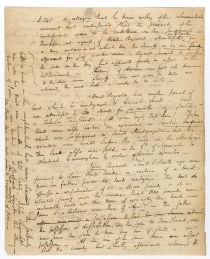
|
The Only Known Document in Hamilton’s Hand on a Legal Case Involving James Reynolds
ALEXANDER HAMILTON,
Autograph Manuscript, c. November 1796, Notes regarding Margaret Currie, administratrix of David Currie v. James Reynolds (scire facias), 2 pp.
Also see the Alexander Hamilton Collection: The Story of the Revolution & Founding.
“There was also a prior Judgment against David Reynolds & his son James … but did not return the Execution nor sell till Wednesday the 2d of November, when James Reynolds about 6 Months ago came forward to claim these lands in virtue of a deed from his father prior to Sands mortgage.”
In July 1783, James Reynolds married Maria Lewis. From mid-1791 to mid-1792, Alexander Hamilton and Maria Reynolds had an affair. In November 1792, James Reynolds was imprisoned for forgery in a scheme to purchase the pensions and pay claims of Revolutionary War soldiers. Ironically, in May 1793, Maria (represented by Aaron Burr) filed for divorce from James on the grounds of adultery; the court granted the divorce two years later. Here, after Hamilton’s affair was known to James Monroe and very few others, Hamilton was somehow involved in a legal case having to do with James Reynolds just months before news of the scandal exploded.
Item #24624, $30,000
|
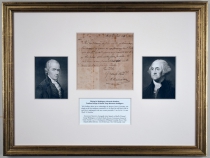
|
For Washington, Hamilton Confirms Receipt of Hessian Troop Movement Intelligence
ALEXANDER HAMILTON,
Autograph Letter Signed, on behalf of General George Washington, to Colonel Charles Stewart, Commissary General of Issues, October 24, 1777, Headquarters [Whitpain Township, Pa]. 1p. with integral address leaf note, “Let the Bearer pass. Tim. Pickering Adjt. Genl.,” 13 x 8¼ in. (open).
Also see the Alexander Hamilton Collection: The Story of the Revolution & Founding.
Following the punishing battles at Paoli and Germantown, which left Philadelphia vulnerable to British control for the winter, the Continental Army under Washington spent two weeks recovering at Whitpain, Pennsylvania.
Alexander Hamilton was then Washington’s chief staff aide, with the rank of Lieutenant Colonel, a position he would hold for four years. He played a crucial role in handling much of the General’s correspondence with Congress, state governors, and other military officers.
Item #24375, $35,000
|
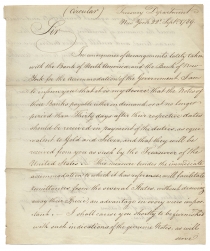
|
Alexander Hamilton’s Initial Steps to Create a National Banking System
Alexander Hamilton,
Circular Letter Signed as Secretary of the Treasury, “Alexr Hamilton/Secy of the Treasury,” to Stephen Smith Esq., Collector of the Customs for the Port of Machias, Massachusetts [Maine], September 22, 1789, New York, New York. 2 pp., 7¾ in. x 9¼ in.
Also see the Alexander Hamilton Collection: The Story of the Revolution & Founding
On his 11th day as Secretary of the Treasury, Hamilton orders Customs Collectors to accept Bank of North America and Bank of New York notes as the equivalent of gold or silver, and hints at forthcoming procedures to guard against counterfeit currency.
“In consequence of arrangements lately taken with the Bank of North America, and the Bank of New York for the accommodation of the Government, I am to inform you that it is my desire that the Notes of those Banks payable either on demand, or at no longer period than Thirty days after their respective dates should be received in payment of the duties, as equivalent to Gold and Silver . . .”
Item #26524, $70,000
|

|
Hamilton Countering Biases Affecting New York Taxes
ALEXANDER HAMILTON,
Autograph Letter fragment, to Robert Morris, c. August 1, 1782, (heavily damaged with text loss) with many edits, from an approximately ten-page draft. The final draft, in Alexander Hamilton’s papers, dates August 13, 1782. 2 pp., 8⅜ x 10¼ in.
Also see the Alexander Hamilton Collection: The Story of the Revolution & Founding
A previously unrecorded partial draft of Hamilton’s famous letter to Superintendent of Finance Robert Morris. Hamilton discusses the “situation and temper” of New York, and its tax plan, which was intended to be based on a fair assessment of her citizens’ circumstances and abilities to pay.
“perhaps the true reason was a desire to discriminate between the whigs and tories. This chimerical attempt at perfect equality has resulted in total inequality”
Item #24619, $17,500
|

|
Hamilton Supports Anyone but Jefferson to Replace Washington as President
ALEXANDER HAMILTON,
Draft Autograph Letter, on George Washington’s declining a third term, and the importance of Jefferson not being president, c. November 8, 1796. Heavily marked and edited draft. Possibly to Jeremiah Wadsworth. 2 pp., 8 x 13 in.
Item #24639, PRICE ON REQUEST
|

|
A Letter from Phocion to the Considerate Citizens of New-York, on the Politics of the Times, in Consequence of the Peace
ALEXANDER HAMILTON,
Pamphlet. A Letter from Phocion to the Considerate Citizens of New-York, on the Politics of the Times, in Consequence of the Peace. Philadelphia: Robert Bell, 1784. Modern green half morocco and cloth, spine gilt. One of two Philadelphia editions of this influential political tract, after the first New York printing that same year. 16 pp.
Currently offered only as part of the Alexander Hamilton Collection: The Story of the Revolution & Founding.
As “Phocion,” Hamilton articulates an early incarnation of the Federalist creed, including compliance with the 1783 peace treaty with Britain, an end to attacks on Tories and Tory property, and the submission of the states to the central authority of the United States. This essay was only Hamilton’s third political tract, and the first of his mature writings on policy.
Item #24313, PRICE ON REQUEST
|
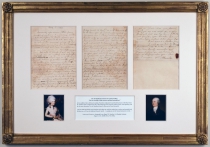
|
One of Hamilton’s Most Revealing Love Letters to Eliza:
“You are certainly a little sorceress and have bewitched me”
ALEXANDER HAMILTON,
Autograph Letter Signed “A. Hamilton,” to Elizabeth Schuyler, August 8, 1780. [Dobbs Ferry, New York]. 4 pp. including partial integral leaf; lacking portion of page below signature; perhaps his signature on address relief was removed. 6½ x 8½ in.
Currently offered only as part of the Alexander Hamilton Collection: The Story of the Revolution & Founding
“you have made me disrelish every thing that used to please me, and have rendered me as restless and unsatisfied with all about me, as if I was the inhabitant of another world. ... I would go on, but the General summons me to ride....”
In the middle of their whirlwind courtship, Hamilton emphasizes his profound fascination with Eliza Schuyler. Hamilton both complains that she is distracting him from important military duties, while pleading with her for more distraction. Few of Hamilton’s letters to Eliza survive from this period.
As Hamilton was writing, tactical intelligence was being communicated at a frantic pace up and down the Hudson. On July 21, Washington had received intelligence from the Culper spy ring on British General Clinton’s planned attack on Rochambeau’s French squadron at Newport, and the massing of British troops on Long Island for an intensified invasion of New York. Hamilton now was in the middle of authoring a detailed “Plan for an Attack on New York” to recapture Manhattan and Brooklyn from the British. He mentions at the end of this letter his position at Dobbs Ferry, New York, a small town on the Hudson where the army was encamped. Hamilton ends when he is summoned by General Washington.
Item #24329, PRICE ON REQUEST
|

|
Hamilton’s Advice to Holland Land Company on a New Law Relating to New York State’s Prohibition Against Foreigners Owning Land
ALEXANDER HAMILTON,
Autograph Manuscript Draft, to Théophile Cazenove, c. May 19, 1796. 2+ pp.
Also see the Alexander Hamilton Collection: The Story of the Revolution & Founding
“It is manifestly the interest of the parties concerned to avail themselves of this act. They are now intirely at the discretion of the Government....”
New York adhered to the common-law prohibition against foreigners owning land. If a citizen purchased property in his own name but the money came from a foreigner, the purchaser was considered a trustee, and the State could seize the property. But Dutch investors, second only to France in their aid to America during the Revolution, invested heavily in American stocks, bonds, and western lands, working largely through their agent Théophile Cazenove.
Item #24625, $20,000
|
|